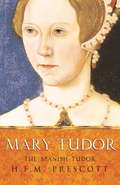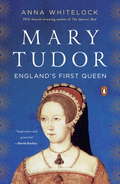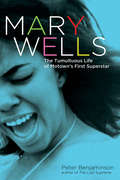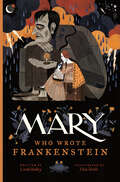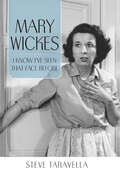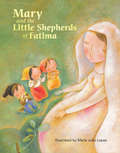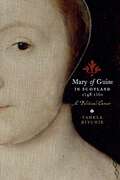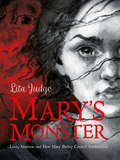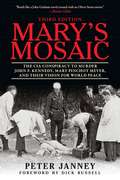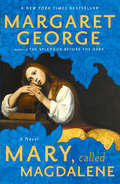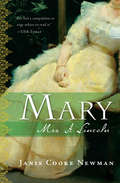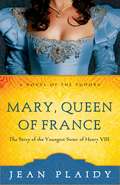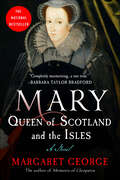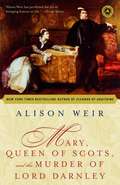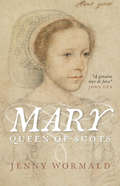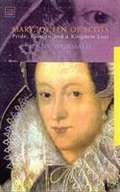- Table View
- List View
Mary Tudor (Women In History Ser.)
by H.F.M. PrescottA highly-readable popular biography of 'Bloody Mary' - winner of the James Tait Black prize.Mary I is notorious for her persecution of Protestants and has been vilified by generations of partisan historians. H.F.M. Prescott brings a more humane and measured perspective to the life of this tormented woman. First published in 1940 under the title SPANISH TUDOR, Prescott's biography won the James Tait Black prize the following year. An extensively revised and updated edition was published in 1953 under the title MARY TUDOR.Prescott sums up her subject's life as follows: 'Perhaps no other reign in English history has seen such a great endeavour made, and so utterly defeated. All that Mary did was undone, all she intended utterly unfulfilled...mistaken often, almost always misguided in her public office, with much blindness, some rancour, some jealousy, some stupid cruelty to answer for, she had yet trodden, lifelong and manfully, the way that other sinners know.'
Mary Tudor: Courageous Queen or Bloody Mary?
by Jane BuchananBiography of Mary Tudor, Queen of England
Mary Tudor: England's First Queen
by Anna WhitelockAn engrossing, unadulterated biography of "Bloody Mary"--elder daughter of Henry VIII, Catholic zealot, and England's first reigning Queen Mary Tudor was the first woman to inherit the throne of England. Reigning through one of Britain's stormiest eras, she earned the nickname "Bloody Mary" for her violent religious persecutions. She was born a princess, the daughter of Henry VIII and the Spanish Katherine of Aragon. Yet in the wake of Henry's break with Rome, Mary, a devout Catholic, was declared illegitimate and was disinherited. She refused to accept her new status or to recognize Henry's new wife, Anne Boleyn, as queen. She faced imprisonment and even death. Mary successfully fought to reclaim her rightful place in the Tudor line, but her coronation would not end her struggles. She flouted fierce opposition in marrying Philip of Spain, sought to restore England to the Catholic faith, and burned hundreds of dissenters at the stake. But beneath her hard exterior was a woman whose private traumas of phantom pregnancies, debilitating illnesses, and unrequited love played out in the public glare of the fickle court. Though often overshadowed by her long-reigning sister, Elizabeth I, Mary Tudor was a complex figure of immense courage, determination, and humanity--and a political pioneer who proved that a woman could rule with all the power of her male predecessors.
Mary Tudor: The First Queen
by Linda PorterA striking and sympathetic portrait of England's first Queen, Mary I - whose character has been vilified for over 400 years. Instead of the bloodthirsty bigot of Protestant mythology, Mary Tudor emerges from the pages of this deeply-researched biography as a cultured renaissance princess, a courageous survivor of the violent power struggles that characterised the reigns of her father, Henry VIII, and brother Edward VI. The author does not belittle Mary's burning of heretics, which earned her the subriquet 'Bloody Mary', but she also had many endearing personal qualities and talents, not least the courage of leadership she showed in facing down Northumberland's rebellion. A well-balanced and readable biography of Mary I is long overdue.
Mary Tudor: The First Queen
by Linda PorterA striking and sympathetic portrait of England's first Queen, Mary I - whose character has been vilified for over 400 years. Instead of the bloodthirsty bigot of Protestant mythology, Mary Tudor emerges from the pages of this deeply-researched biography as a cultured renaissance princess, a courageous survivor of the violent power struggles that characterised the reigns of her father, Henry VIII, and brother Edward VI. The author does not belittle Mary's burning of heretics, which earned her the subriquet 'Bloody Mary', but she also had many endearing personal qualities and talents, not least the courage of leadership she showed in facing down Northumberland's rebellion. A well-balanced and readable biography of Mary I is long overdue.
Mary Walker Wears the Pants
by Cheryl Harness Carlo MolinariThe story of Mary Edwards Walker, the doctor and women's rights activist who served in the Civil War and received the Medal of Honor. Mary Edwards Walker was unconventional for her time: She was one of the first women doctors in the country, she was a suffragist, and she wore pants! And when the Civil War struck, she took to the battlefields in a modified Union uniform as a commissioned doctor. For her service, she became the only woman ever to earn the Medal of Honor. This picture book biography tells the story of a remarkable woman who challenged traditional roles and lived life on her own terms. This is a fixed-format ebook, which preserves the design and layout of the original print book.
Mary Ward: First Sister of Feminism
by Sydney ThorneAlmost exactly 400 years ago, an English woman completed an astonishing walk to Rome. An English Catholic, Mary Ward had already defied the authorities in England. In 1621 she walked across Europe to ask the Pope to allow her to set up schools for girls. 'There is no such difference between men and women that women may not do great things,' she said. But Mary’s vision of equality between men and women angered the Catholic Church and the Pope threw her into prison. This is a story just waiting to be told! The story shines a refreshingly new light on the popular Tudor/Stuart era. Mary’s uncles are the Gunpowder Plotters. Her sponsors are Archdukes, Prince-Archbishops and the Emperor of the Holy Roman Empire. In Rome she spars with Pope Urban VIII and the Roman Inquisition, just as they are also dealing with Galileo. As the story sweeps from Yorkshire to Rome, from Vienna and Munich to Prague and back to England, we see Mary dodging pirates in the Channel, witch hunts in Germany and the plague in Italy. We see travellers crossing the Alps, and prisoners writing letters in invisible lemon juice to smuggle them past their gaolers. The settings range from the resplendent courts in Brussels and Munich to the siege of York in the English Civil War. The reader is immersed in seventeenth-century life.
Mary Wells: The Tumultuous Life of Motown's First Superstar
by Peter BenjaminsonComplete with never-before-revealed details about the sex, violence, and drugs in her life, this biography reveals the incredibly turbulent life of Motown artist Mary Wells. Based in part on four hours of previously unreleased and unpublicized deathbed interviews with Wells, this account delves deeply into her rapid rise and long fall as a recording artist, her spectacular romantic and family life, the violent incidents in which she was a participant, and her abuse of drugs. From tumultuous affairs, including one with R&B superstar Jackie Wilson, to a courageous battle with throat cancer that climaxed in her gutsiest performance, this history draws upon years of interviews with Wells's friends, lovers, and husband to tell the whole story of a woman whose songs crossed the color line and whose voice captivated the Beatles.
Mary Who Wrote Frankenstein (Who Wrote Classics)
by Linda BaileyThe inspiring story of the girl behind one of the greatest novels -- and monsters -- ever, perfectly timed for the 200th anniversary of the publication of Frankenstein. For fans for picture book biographies such as I Dissent or She Persisted.How does a story begin? Sometimes it begins with a dream, and a dreamer. Mary is one such dreamer, a little girl who learns to read by tracing the letters on the tombstone of her famous feminist mother, Mary Wollstonecraft, and whose only escape from her strict father and overbearing stepmother is through the stories she reads and imagines. Unhappy at home, she seeks independence, and at the age of sixteen runs away with poet Percy Bysshe Shelley, another dreamer. Two years later, they travel to Switzerland where they meet a famous poet, Lord Byron. On a stormy summer evening, with five young people gathered around a fire, Byron suggests a contest to see who can create the best ghost story. Mary has a waking dream about a monster come to life. A year and a half later, Mary Shelley's terrifying tale, Frankenstein: or, the Modern Prometheus, is published -- a novel that goes on to become the most enduring monster story ever and one of the most popular legends of all time.A riveting and atmospheric picture book about the young woman who wrote one of the greatest horror novels ever written and one of the first works of science fiction, Mary Who Wrote Frankenstein is an exploration of the process of artistic inspiration that will galvanize readers and writers of all ages.
Mary Wickes: I Know I've Seen That Face Before (Hollywood Legends Series)
by Steve TaravellaMoviegoers know her as the housekeeper in White Christmas, the nurse in Now, Voyager, and the crotchety choir director in Sister Act. This book, filled with never-published behind-the-scenes stories from Broadway and Hollywood, chronicles the life of a complicated woman who brought an assortment of unforgettable nurses, nuns, and housekeepers to life on screen and stage. Wickes (1910–1995) was part of some of the most significant moments in film, television, theatre, and radio history. On that frightening night in 1938 when Orson Welles recorded his earth-shattering “War of the Worlds” radio broadcast, Wickes was waiting on another soundstage for him for a rehearsal of Danton's Death, oblivious to the havoc taking place outside. When silent film star Gloria Swanson decided to host a live talk show on this new thing called television, Wickes was one of her first guests. When Lucille Ball made one of her first TV appearances, Wickes appeared with her—and became Lucy's closest friend for more than thirty years. Wickes was the original Mary Poppins, long before an umbrella carried Julie Andrews across the rooftops of London. And when Disney began creating 101 Dalmatians, Wickes was asked to pose for animators trying to capture the evil of Cruella De Vil. The pinched-face actress who cracked wise by day became a confidante to some of the day's biggest stars by night, including Bette Davis and Doris Day. Bolstered by interviews with almost three hundred people, and by private correspondence from Ball, Davis, Day, and others, Mary Wickes: I Know I've Seen That Face Before includes scores of never-before-shared anecdotes about Hollywood and Broadway. In the process, it introduces readers to a complex woman who sustained a remarkable career for sixty years.
Mary and Lou and Rhoda and Ted
by Jennifer Keishin ArmstrongThe story of the making of a classic and groundbreaking TV show, as experienced by its producers, writers, and cast. Mary Tyler Moore made her name as Dick Van Dyke's wife on the eponymous show, a cute, unassuming housewife that audiences loved. But when her writer/producers James Brooks and Allan Burnes dreamed up an edgy show about a divorced woman with a career, network executives replied: "Americans won't watch television about New York City, divorcees, men with mustaches, or Jews." But Moore and her team were committed, and when the show finally aired, in spite of tepid reviews, fans loved it. Jennifer Armstrong introduces readers to the show's creators; its principled producer, Grant Tinker; and the writers and actors who attracted millions of viewers. As the first situation comedy to employ numerous women as writers and producers, The Mary Tyler Moore Show became a guiding light for women in the 1970s. The show also became the centerpiece of one of greatest evenings of comedy in television history, and Jennifer Armstrong describes how the television industry evolved during these golden years.
Mary and Mr. Eliot: A Sort of Love Story
by Erica Wagner Mary TrevelyanMary and Mr. Eliot is a twin portrait of T. S. Eliot and its author, the formidable Mary Trevelyan.In 1938 T. S. Eliot, already “a Classic in his lifetime,” struck up a friendship with Mary Trevelyan. This passionately curious woman, an intrepid traveler who, like Eliot, was deeply involved in the affairs of the Church of England, served as the warden of the Student Movement House, mere yards from the poet and editor’s office at Faber and Faber. Their relationship was domestic rather than artistic, characterized by churchgoing, conversation, record-playing, day trips to the English countryside with Mary at the wheel of the car Tom bought her, and Eliot cooking up sausages in his shirtsleeves. Over the years, their friendship deepened, and she came to believe it might grow into something more. Twice she proposed marriage, but Eliot always led her to understand that any such commitment would be impossible for him. Then the revelation of his long attachment to Emily Hale—and the sudden shock of his marriage to his secretary, Valerie Fletcher—caused a rupture between Trevelyan and the poet that could not be overcome. Mary Trevelyan left a unique chronicle— including diaries, letters, and pictures—that charts their twenty-year relationship. Now Erica Wagner has given it shape and context, bringing this untold story to light for the first time. Mary and Mr. Eliot is a tale of joy, misunderstanding, and betrayal that feels utterly modern and deeply human.
Mary and the Little Shepherds of Fatima
by Jaymie Stuart Wolfe Marlyn Monge Sr. Maria João LopesCelebrate the 100th anniversary of the apparitions at Fátima, Portugal with this charmingly illustrated true story designed to delight and educate children ages 5 to 8. Answering the Blessed Mother’s call to pray the Rosary and make small sacrifices to help bring an end to WWI, Francisco, Jacinta, and Lucia faced persecution and doubt with unwavering faith and confidence. Read how their courage and desire to spread the Rosary helped thousands witness Our Lady’s Miracle of the Sun!
Mary of Guise in Scotland, 1548–1560: A Political Career
by Pamela E. RitchieChallenging the conventional interpretation of Mary of Guise as the defender of Catholicism whose regime climaxed with the Reformation Rebellion, Pamela Ritchie shows that Mary was, on the contrary, a shrewd and effective politique, whose own dynastic interests and those of her daughter took precedence over her personal and religious convictions. Dynasticism, not Catholicism, was the prime motive force behind her policy. Mary of Guise’s dynasticism, and political career as a whole, were inextricably associated with those of Mary Queen of Scots, whose Scottish sovereignty, Catholic claim to the English throne and betrothal to the Dauphin of France carried with them notions of Franco-British Imperialism. Mary of Guise's policy in Scotland was dictated by European dynastic politics and, specifically, by the Franco-Scottish alliance of 1548–1560. Significantly more than a betrothal contract, the Treaty of Haddington established a ‘protectoral’ relationship between the ‘auld allies’ whereby Henri II was able to assume control over Scottish military affairs, diplomacy and foreign policy as the ‘protector’ of Scotland. Mary of Guise’s assumption of the regency in 1554 completed the process of establishing French power in Scotland, which was later consolidated, albeit briefly, by the marriage of Mary Stewart to Francois Valois in 1558. International considerations undermined her policies and weakened her administration, but only with her death did Mary of Guise’s regime and French power in Scotland truly collapse.
Mary on Horseback
by Rosemary WellsTells the stories of three families who were helped by Mary Breckinridge, the first nurse to go into Appalachian Mountains and give medical care to the isolated inhabitants. Also tells about Breckrinridge and Frontier Nursing Service she founded.
Mary's Monster: Love, Madness and How Mary Shelley Created Frankenstein
by Lita JudgeThe dark, captivating story of one remarkable young woman. And her monster.Creative genius...? Inventor of science fiction...? Pregnant teenage runaway...? Who was the real Mary Shelley? Mary's Monster is the compelling and beautifully illustrated story of Frankenstein's author Mary Shelley - the original rebel girl and an inspiration for everyone from teenage readers to adult. Aged 16 and pregnant, Mary runs away to Switzerland with the married poet Percy Bysshe Shelley. Few people would have guessed that that fateful act would lead to a gothic novel still celebrated 200 years later. But cast out by her family and isolated by society, Mary Shelley created Frankenstein and his monster, forged in the fire of her troubled and tragic life. Part biography and part graphic novel, Mary's Monster is an engrossing take on one remarkable young woman and her monster.
Mary's Monster: Love, Madness, and How Mary Shelley
by Lita Judge<p>Pairing free verse with over three hundred pages of black-and-white watercolor illustrations, Mary’s Monster is a unique and stunning biography of Mary Shelley, the pregnant teenage runaway who became one of the greatest authors of all time. <p>Legend is correct that Mary Shelley began penning Frankenstein in answer to a dare to write a ghost story. What most people don't know, however, is that the seeds of her novel had been planted long before that night. By age nineteen, she had been disowned by her family, was living in scandal with a married man, and had lost her baby daughter just days after her birth. Mary poured her grief, pain, and passion into the powerful book still revered two hundred years later, and in Mary's Monster, author/illustrator Lita Judge has poured her own passion into a gorgeous book that pays tribute to the life of this incredible author.</p>
Mary's Mosaic: The CIA Conspiracy to Murder John F. Kennedy, Mary Pinchot Meyer, and Their Vision for World Peace: Third Edition
by Dick Russell Peter JanneyExplores the murder of Mary Pinchot Meyer and her connected to President KennedyIdeal book for fans of The Devil’s Chessboard by David Talbot, The Reporter Who Knew Too Much by Dorothy Kilgallen, Dr. Mary’s Monkey by Edward T. Haslam, and other JFK conspiracy booksUpdated edition of the true crime expose, including new evidence and government documents corroborating the conspiracy to assassinate JFK’s trusted ally and final true loveThe death of Mary Meyer left many Americans with questions. Who really killed her? Why did CIA counterintelligence chief James Angleton rush to find and confiscate her diary? Had she discovered the plan to assassinate her lover, President Kennedy, with the trail of information ending at the steps of the CIA? Was it only coincidence that she was killed less than three weeks after the release of the Warren Commission Report?Fans of The Murder of Mary Russell, JFK: A Vision for America, and other JFK books will love Mary’s Mosaic. Building and relying on years of interviews and painstaking research, author Peter Janney follows the key events and influences in Mary Pinchot Meyer’s life—her first meeting with Jack Kennedy; her support of her secret lover, President Kennedy, as he worked towards the pursuit of world peace and away from the Cold War; and her exploration of psychedelic drugs. Fifty years after the assassinations of President Kennedy and Mary Meyer, this book helps readers understand why both took place. Author Peter Janney fought for two years to obtain documents from the National Personnel Records Center and the US Army to complete this third edition. It includes a final chapter about the mystery man who could be the missing piece to learn the truth behind Meyer’s murder.
Mary, Called Magdalene: A Novel
by Margaret GeorgeThe New York Times bestselling author of Elizabeth I brilliantly reimagines the story of the most mysterious woman in the Bible.Was Mary Magdalene a prostitute, a female divinity figure, a church leader, or all of those? Biblical references to her are tantalizingly brief, but we do know that she was the first person to whom the risen Christ appeared--and the one commissioned to tell others the good news, earning her the ancient honorific, "Apostle to the Apostles." Today, Mary continues to spark controversy, curiosity, and veneration. In a vivid re-creation of Mary Magdalene's life story, Margaret George convincingly captures this renowned woman's voice as she moves from girlhood to womanhood, becomes part of the circle of disciples, and comes to grips with the divine. While grounded in biblical scholarship and secular research, Mary, Called Magdalene ultimately transcends both history and fiction to become a "diary of a soul."From the Trade Paperback edition.
Mary, Mrs. A. Lincoln: A Novel
by Janis Cooke NewmanA novel about the life of Mary Todd Lincoln, narrated by the First Lady herself, a USA Today choice for Best Historical Fiction of the Year. The wife of Abraham Lincoln is one of history&’s most misunderstood and enigmatic women. She was a political strategist, a supporter of emancipation, and a mother who survived the loss of three children and the assassination of her beloved husband. She also ran her family into debt, held seances in the White House, and was committed to an insane asylum—which is where Janis Cooke Newman&’s debut novel begins. From her room in Bellevue Place, Mary chronicles her tempestuous childhood in a slaveholding Southern family and takes readers through the years after her husband&’s death, revealing the ebbs and flows of her passion and depression, her poverty and ridicule, and her ultimate redemption, in a novel that is both a fascinating look at a nineteenth-century woman&’s experience and &“an old-fashioned pleasure to read&” (The Plain Dealer). A Los Angeles Times Book Prize Finalist
Mary, Queen of France (Tudor Saga #9)
by Jean PlaidyLegendary historical novelist Jean Plaidy brings to life the story of Princess Mary Tudor, a celebrated beauty and born rebel who would defy the most powerful king in Europe--her older brother.Princess Mary Rose is the youngest sister of Henry VIII, and one of the few people whom he adores unconditionally. Known throughout Europe for her charm and good looks, Mary is the golden child of the Tudor family and is granted her every wish.Except when it comes to marriage. Henry VIII, locked in a political showdown with France, decides to offer up his pampered baby sister to secure peace between the two mighty kingdoms. Innocent, teenage Mary must become the wife of the elderly King Louis, a toothless, ailing man in his sixties. Horrified and furious, Mary has no choice but to sail for France. There she hones her political skills, bides her time, and remains secretly in love with Charles Brandon, the Duke of Suffolk. When King Louis dies, after only two years of marriage, Mary is determined not to be sold into another unhappy union. She must act quickly; if she wants to be with the man she truly loves, she must defy the laws of church and state by marrying without her brother's permission. Together, Mary and Charles devise a scheme to outwit the most ruthless king in Europe and gain their hearts' desire, not knowing if it will lead to marital bliss or certain death. From the Trade Paperback edition.
Mary, Queen of Scotland and the Isles: A Novel
by Margaret George“A massive, erudite, and entertaining novel . . . skillfully weaves historical fact and plausible fiction” to tell the story of Mary Queen of Scots (New York Newsday).She was a child crowned a queen. . . .A sinner hailed as a saint. . . .A lover denounced as a whore . . .A woman murdered for her dreams . . .Margaret George’s national bestselling Mary Queen of Scotlandand the Isles brings to life the fascinating story of Mary, who became the Queen of Scots when she was only six days old. Raised in the glittering French court, returning to Scotland to rule as a Catholic monarch over a newly Protestant country, and executed like a criminal in Queen Elizabeth’s England, Queen Mary lived a life like no other, and Margaret George weaves the facts into a stunning work of historical fiction.“The best kind of historical novel, one the reader can’t wait to get lost in.” —San Francisco Chronicle“George has created a lively, gallant Mary of intelligence, charm and terrible judgment . . . A popular, readable, inordinately moving tribute to a remarkable queen.” —Kirkus Reviews“An engrossing novel. . . . [George’s] deep sympathy for her subject renders Mary an entirely real and unforgettable heroine.” —Publishers Weekly“Dramatic . . . Romantic . . . George makes Mary a heroine to identify with because of her spirit, wit and charm . . . A triumph.” —Houston Chronicle“An evocative portrait.” —The New York Times Book Review
Mary, Queen of Scots, and the Murder of Lord Darnley: And The Murder Of Lord Darnley
by Alison WeirHandsome, accomplished, and charming, Henry Stuart, Lord Darnley, staked his claim to the English throne by marrying Mary Stuart, who herself claimed to be the Queen of England. It was not long before Mary discovered that her new husband was interested only in securing sovereign power for himself. Then, on February 10, 1567, an explosion at his lodgings left Darnley dead; the intrigue thickened after it was discovered that he had apparently been suffocated before the blast. After an exhaustive reevaluation of the source material, Alison Weir has come up with a solution to this enduring mystery. Employing her gift for vivid characterization and gripping storytelling, Weir has written one of her most engaging excursions yet into Britain's bloodstained, power-obsessed past.From the Trade Paperback edition.
Mary, Queen of Scots: Now A Major New Film (The Stewart Dynasty in Scotland #8)
by Jenny WormaldThe acclaimed Scottish historian offers a provocative reassessment of one of British royalty&’s most famous figures in this authoritative biography. Mary Stuart, Queen of Scots, has long been portrayed as one of history&’s romantically tragic figures. Devious, naive, beautiful and sexually voracious, often highly principled, she secured the Scottish throne and bolstered the position of the Catholic Church in Scotland. Her plotting, including probable involvement in the murder of her husband Lord Darnley, led to her flight from Scotland and imprisonment by her equally ambitious cousin and fellow queen, Elizabeth of England. Yet when Elizabeth ordered Mary&’s execution in 1587 it was an act of exasperated frustration rather than political wrath. Unlike previous biographies of Mary, this masterly study eschews her romantic persona in order to shine a light on her role as a renaissance monarch. A leading historian of the period, Jenny Wormald traces the roots of Mary&’s downfall to her way of dealing, or failing to deal, with the problems facing her as a ruler. She was tragic because she was born to supreme power yet wholly incapable of coping with its responsibilities.
Mary, Queen of Scots: Pride, Passion and a Kingdom Lost
by Jenny WormaldMary Stuart, Queen of Scots, was one of history's romantically tragic figures. Devious, naive, often principled, beautiful and sexually voracious, this was a woman who had secured the Scottish throne and bolstered the position of the Catholic Church in Scotland. Her endless plotting, including a probable involvement in the murder of her husband Lord Darnley, eventually led to her flight from Scotland and imprisonment by her equally ambitious cousin and fellow queen, Elizabeth I of England. And yet when Elizabeth ordered her unpredictable rival and kinswoman to be beheaded in 1587, she did so in resigned frustration rather than as an act of political wrath. Was the beheading of a cousin truly necessary? Did Mary, though churlish, petulant and often disloyal, deserve to forfeit the compassion of her cousin, a woman who had since childhood been her friend and playmate? Mary's fragile fate was to be born to supreme power whilst totally lacking in the political ability to deal with its responsibilities. Her story, which has inspired poets, playwrights and operatic composers of the centuries, is one of the most colourful and emotional tales of Western history, and is here told by a specialist of the 16th century.
